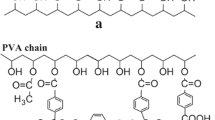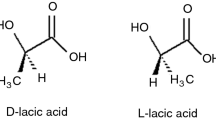Abstract
Atactic poly(vinyl alcohol) (at-PVA) and syndiotactic poly(vinyl alcohol) (st. PVA) prepared by gelation/crystallization using dimethyl sulphoxide/water mixtures were drawn in a hot oven at 160 °C under nitrogen. The degrees of polymerization of at- and st-PVA were 2000 and 1980, respectively. The drawability of at- and st-PVA films was affected by the composition of the solvent mixture as well as by quenching temperature. The drawability of at- and st-PVA films prepared by using the solvent mixture containing 60% of dimethyl sulphoxide and 40% of water became more pronounced as the temperature of gelation/crystallization decreased and the draw ratio reached maximum value at −80 °C. Namely, the greatest significant drawability was the same condition for at- and st-PVA films in spite of the different stereo-regularity. Even in this common best condition for significant drawability, however, the morphological properties of swollen gels and of the resultant dry gel films are different each other, dependent upon the tacticity. For at-PVA, small-angle light scattering under Hv polarization condition could not be observed in the swollen gels and in the dry films when the solutions were quenched at temperatures <−10 °C. In contrast, for st-PVA, the X-type scattering pattern from swollen gels became clearer as the temperature decreased but the pattern became indistinct under drying process at ambient condition. On the other hand, the fibrillar textures within the at- and st-PVA dry films became finer and the orresponding crystallinity became lower as the temperature of gelation/crystallization decreased. Thus it turned out that the morphological properties of the swollen gels and of the dried films play an important role to assure the greatest significant drawability.
Similar content being viewed by others
References
Hulse G, Kersting RJ, Warful DR (1981) J Polym Sci Polym Phys Ed 19:655
Wang CS, Yeh GS (1981) Polym J 13:341
Bhateja SK (1983) J Macromol Sci Phys B22(1):159
de Boer J, van den Berg H-J, Pemgs AJ (1984) Polymer 25:513
Matsuo M, Sawatari C (1986) Macromolecules 19:2028
Matsuo M, Sawatari C (1987) Macromolecules 20:1745
Yamaura K, Katoh H, Tanigami T, Matsuzawa S (1987) J Appl Polym Sci 34:2345
Yamaura K, Itoh M, Tanigami T, Matsuzawa S (1989) J Appl Polym Sci 37:2709
Yamaura K, Tanigami T, Hayashi N, Okura S, Takemura Y, Itoh M, Matsuzawa S (1990) J Appl Polym Sci 40:905
Sawatari C, Yamamoto Y, Yanagida N, Matsuo M (1993) Polymer 34:956
Matsuo M Kawase M, Sugiura Y, Takematsu S, Hara C (1993) Macromolecules 26:4461
Cha WI, Hyon SH, Ikeda Y (1994) J Polym Sci Polym Phys Ed 32:297
Mori S (1978) J Chromatogr 157:75
Sakurada I, Nukushina K, Sone Y (1955) Koubunshi Kagaku 12:506
Smith P, Lemstra PJ, Pijpers JPL, Kiel AM (1981) Colloid Polym Sci 258:1070
Matsuo M, Inoue K, Abumiya N (1984) Sen-i Gakkaishi 40:275
Matsuo M, Sawatari C, Iida M, Yoneda M (1985) Polymer J 17:1197
Matsuo M, Tamada M, Terada T, Sawatari C, Niwa M (1982) Macromolecules 15:988
Sawatari C, Iida M, Matsuo M (1984) Macromolecules 17:1765
Sakurada I, Nukushina Y, Ito T (1962) J Polym Sci 57:651
Matsuo M, Harashima Y, Ogita T (1993) Polymer J 25:319
Author information
Authors and Affiliations
Rights and permissions
About this article
Cite this article
Ogita, T., Sakabe, T., Yamada, T. et al. Morphology of poly(vinyl alcohol) gels assuring the greatest significant drawability. Colloid Polym Sci 274, 928–937 (1996). https://doi.org/10.1007/BF00656622
Received:
Accepted:
Issue Date:
DOI: https://doi.org/10.1007/BF00656622




